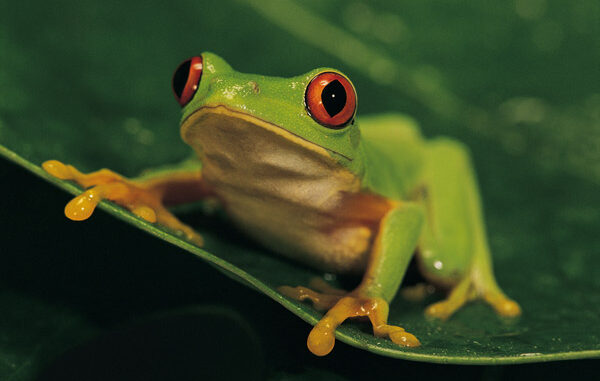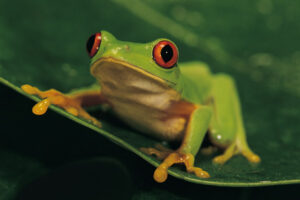

Comstock Images/Alamy
A red-eyed tree frog.
Costa Rica, one of the most biodiverse nations in the world, is home to an unbelievable variety of exotic wildlife, including the red-eyed tree frog. All the national parks and rain forests also offer ideal habitats for other animals, such as poison dart frogs, playful monkeys, furry and lazy sloths, venomous snakes, white-nosed coati, sleek jaguars, and thousands of bats and beautiful birds and butterflies.
Why do you think these frogs are called red-eyed tree frogs? Because they have bulging red eyes and live in trees, of course! Red-eyed tree frogs range from 1½ to 2½ inches in size, live about four to five years in the wild, and are harmless. They live in the trees of Costa Rica’s rain forests such as Tortuguero National Park, Manuel Antonio National Park, and Monteverde Cloud Forest Reserve. They rarely go down to the ground. Their feet are like tiny orange suction cups, enabling them to move easily amongst the forests’ leaves and branches. They tend to sleep during the day, but at night they are very active, happily jumping and climbing and springing on insects and moths with their long, sticky tongues. Can you guess an advantage to having big red eyes? If threatened, they suddenly pop open their red eyes, shocking predators such as birds or snakes just long enough to allow the frogs to hop away!
Explore More:
1. Choose a creature that interests you from the article or the slideshow, find out its Spanish name, and learn more about it. Give a report to the class, including visuals.
2. Investigate further the secretions of poison dart frogs. What do scientists think is the source of the toxicity, and why do they lose this toxicity in captivity? What medicinal purposes are being explored, and at what stage is the research?
Share What You Know:
1. Which of all of these animals would you most like to have for a pet? Which would you never have for a pet? Give reasons. Take a poll of the class. Count the responses to find out which would be the most and least popular class pet.
red-eyed tree frog
poison dart frog
capuchin monkey
howler monkey
spider monkey
squirrel monkey
sloth
white-nosed coati
boa constrictor
coral snake
macaw
toucan
butterfly
2. Do you know the Spanish words for frog and monkey? Make up a simple sentence in Spanish about each of these animals and include something you learned in this article.